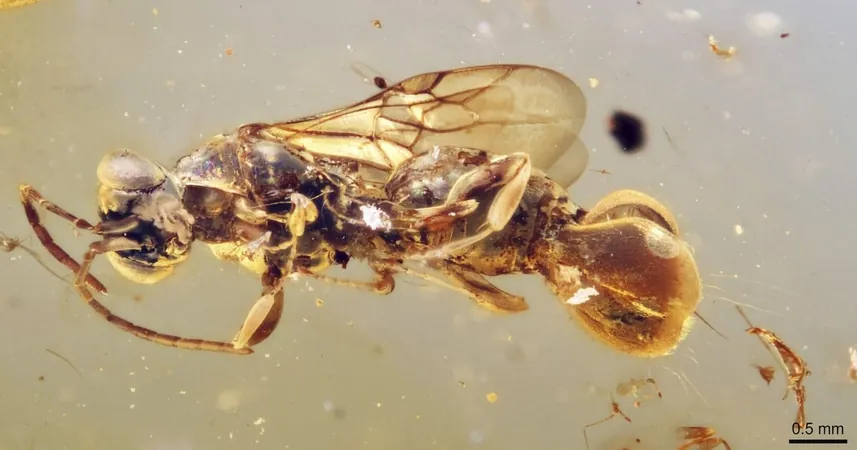
Nature's Unexpected Role in Pain Relief: Groundbreaking Study Unveils Healing Power
2025-03-24
Author: Emily
Introduction
A groundbreaking study published this month has put a fresh spin on the age-old adage that “nature is healing.” The research, featured in the esteemed journal *Nature Communications*, reveals compelling evidence that simply watching scenes of nature can significantly reduce feelings of pain—not merely due to a placebo effect, but by impacting neural activity associated with pain perception.
Insights from Experts
Dr. Karin Dijkstra, a prominent behavioral scientist at Saxion University of Applied Sciences in the Netherlands, applauded the study's design and potential impact, emphasizing its timeliness and unique approach to understanding pain relief through natural stimuli. Notably, this new research builds upon over four decades of evidence that indicates nature's soothing effects on pain perception. A pivotal study from 1984 originally illustrated that hospital patients who had windows with views of nature required less pain medication and discharged faster than those whose rooms faced walls.
Understanding the Mechanisms
Despite the existing body of literature, the underlying mechanisms by which nature alleviates pain have remained less defined. Early hypotheses suggested that nature might lower pain sensation directly or perhaps ease the emotional turmoil associated with it. However, participants’ subjective reports often failed to disentangle these factors.
The Groundbreaking Study
This recent study ingeniously addressed these complexities by utilizing functional magnetic resonance imaging (fMRI) to observe brain activity during painful stimuli. The research team, led by neuroscientist Max Steininger from Universität Wien in Austria, monitored two key neural signatures identified in prior studies: a 'lower-level' signature that indicates the location and intensity of pain, and a 'higher-level' signature that reflects cognitive and emotional responses to pain.
Participants in the study experienced mild shocks while viewing three different types of scenarios: nature scenes, urban environments, and indoor settings. Remarkably, those gazing at nature reported diminished pain intensity and discomfort, with fMRI scans confirming reduced neural activity related to pain detection in the lower-level signature, while higher-level cognitive processing appeared unaffected.
“I initially assumed that a placebo effect would primarily explain these results,” Steininger shared, noting the surprising nature of their findings. The researchers propose that nature's calming effect serves as a distraction, drawing attention away from pain without overwhelming the observer. This 'soft fascination' with natural scenes may help quiet the mind and reduce perceived pain.
Implications for Pain Management
What's more, this discovery holds significant implications for those who may not have easy access to natural environments. “This approach is inclusive and readily available for everyone,” Dijkstra stated, noting that individuals with health conditions limiting outdoor activities can benefit from virtual nature exposure.
Looking ahead, Steininger and his team aim to explore whether these findings extend to chronic pain conditions, such as back pain and arthritis. Given the escalating opioid crisis in the U.S. and Europe, there is a pressing need for nonpharmacological pain management strategies. 'While nature won't be a panacea, it could certainly be part of a broader solution,' he stated.
Steininger emphasized that incorporating nature into pain management strategies could elevate patient care; however, he cautioned patients against adjusting their medication without consulting healthcare professionals—nature should complement, not replace, traditional treatments.
Social Issues and Health Equity
The study also raises critical social issues regarding access to natural spaces. Many individuals from lower socioeconomic backgrounds, who might benefit most from the healing properties of nature, often live in areas lacking green spaces. A stark 76% of residents in low-income communities of color reside in nature-deprived designs, compared to just 23% in predominantly white neighborhoods. This “nature gap” presents a new challenge for health equity.
'This research should prompt action toward preserving our natural ecosystems—not just for environmental reasons but for public health,’ Steininger urged. The connection between accessible natural environments and health outcomes cannot be overstated: protecting biodiversity is as much about safeguarding our planet as it is about safeguarding our health.
Conclusion
As our understanding of the connection between nature and well-being continues to deepen, the implications of this study highlight the urgent need to explore innovative, nature-based healing methods in our healthcare systems. This might not just transform how we manage pain—but also teach us valuable lessons on equity and sustainability.









 Brasil (PT)
Brasil (PT)
 Canada (EN)
Canada (EN)
 Chile (ES)
Chile (ES)
 Česko (CS)
Česko (CS)
 대한민국 (KO)
대한민국 (KO)
 España (ES)
España (ES)
 France (FR)
France (FR)
 Hong Kong (EN)
Hong Kong (EN)
 Italia (IT)
Italia (IT)
 日本 (JA)
日本 (JA)
 Magyarország (HU)
Magyarország (HU)
 Norge (NO)
Norge (NO)
 Polska (PL)
Polska (PL)
 Schweiz (DE)
Schweiz (DE)
 Singapore (EN)
Singapore (EN)
 Sverige (SV)
Sverige (SV)
 Suomi (FI)
Suomi (FI)
 Türkiye (TR)
Türkiye (TR)
 الإمارات العربية المتحدة (AR)
الإمارات العربية المتحدة (AR)